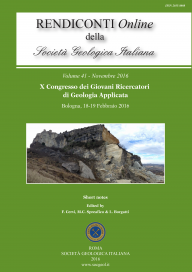
A contribution to the definition of the ongoing climate change and its impacts on the water resources: the case of Monte Fumaiolo (Central Italy)
Lucio Di Matteo (a), Walter Dragoni (b), David Maccari (c) & Simone Maria Piacentini (d)
(a) Department of Physics and Geology, University of Perugia, via A. Pascoli snc, 06123, Perugia, Italy. e-mail: lucio.dimatteo@unipg.it
(b) Department of Physics and Geology, University of Perugia, via A. Pascoli snc, 06123, Perugia, Italy. e-mail: walter.dragoni@unipg.it (Corresponding Author)
(c) Consultant Geologist, Pieve Santo Stefano - Arezzo, Italy. e-mail: maccaridavid@tiscali.it
(d) Department of Physics and Geology, University of Perugia, via A. Pascoli snc, 06123, Perugia, Italy. e-mail: simonemaria.piacentini@studenti.unipg.it
Volume: 41/2016
Pages: 46-49
Abstract
Monte Fumaiolo plateau, located at 1407 m a.s.l. in Northern Apennines (Central Italy), has an extension of about 11 km2. Monte Fumaiolo plateau is constituted by a set of sub-horizontal sandstone formations (San Marino and Monte Fumaiolo sandstones), having a medium-high permeability; the plateau rests on top of a low permeability rock sequence. The plateau is a good aquifer, which gives origin to a large number of small springs and to a few large ones. The Tiber River, one of the largest in Italy, originates from Monte Fumaiolo. In spite of the scarcity of hydrometric data, this preliminary paper attempts to evaluate the water budget of the plateau and the impact of the ongoing climatic change. The results so far obtained indicate statistically significant decrease of the rainfall in winter (i.e. during the recharge season) and a strong increase of temperature, due to a linear gradient of +0.44 °C/decade. This caused a decrease of the total water yield of the plateau, which will continue if the detected trends should keep going.
Keywords
Get Full Text